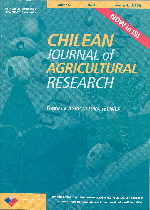
|
Agricultura Técnica
Instituto de Investigaciones Agropecuarias, INIA
ISSN: 0365-2807
EISSN: 0365-2807
Vol. 66, No. 1, 2006, pp. 48-56
|
 Bioline Code: at06006
Bioline Code: at06006
Full paper language: Spanish
Document type: Research Article
Document available free of charge
|
|
|
Agricultura Técnica, Vol. 66, No. 1, 2006, pp. 48-56
| en |
Effect of different irrigation treatments on the fruit load, fruit size and yield of olive trees cv. Sevillana
Selles van Sch., Gabriel; Ferreyra, Raúl E.; Selles, Iván M. & Lemus, Gamalier S.
Abstract
In order to determine the effects of different regulated deficit irrigation (RDC) strategies in olives ( Olea europea

L.), four irrigation treatments were applied, for three seasons, in an eight-year-old orchard of cv. 'Sevillana' olives, growing in the locality of Tierras Blanca, San Felipe, V Region, Chile (32°47' S; 70°42' W; 800 m above sea level). Treatments were: T1, irrigated at 100% of crop evapotranspiration (ETc) for the entire season; T2, 100% ETc from beginning of shoot growth until the end of fruit growth stage II and 40% ETc during stage III; T3, 100% ETc from beginning of shoot growth until the end of fruit growth stage II and 25% ETc during stage III; and T4, 60% ETc throughout the entire season. Both stem water potential and stomatal conductance were affected by RDC, especially when 40 and 25% ETc were applied. During fruit stage III, water stress did not affect the fruit-bearing load, however during this stage severe water stress affected the final fruit weight. Water stress during the whole season (60% ETc), produced a strong reduction on the fruit-bearing load of the season of high production, which seems to have its origin in the previous season. According to the results, the best strategy for RDC in olives seems to be moderate stress (application of 40% Etc) in phase III of fruit growth.
stem water potential, stomatal conductance, regulated deficit irrigation, Olea europaea L.
|
| |
| es |
Efecto de diferentes regimenes de riego sobre la carga frutal, tamaño de fruta y rendimiento del olivo cv. Sevillana
Selles van Sch., Gabriel; Ferreyra, Raúl E.; Selles, Iván M. & Lemus, Gamalier S.
Resumen
Con el objetivo de determinar el efecto de diferentes estrategias de riego deficitario controlado (RDC) en olivos ( Olea europea

L.), se aplicaron cuatro tratamientos de riego, en tres temporadas, a un huerto de ocho años de edad, del cv. Sevillana, ubicado en la localidad de Tierras Blancas, San Felipe, V Región (32°47' lat. Sur, 70°42' long. Oeste, 800 m.s.n.m). Los tratamientos fueron: T1, regado con el equivalente al 100% de la evapotranspiración del cultivo (ETc) durante toda la temporada; T2, 100% de la ETc desde brotación hasta el término de la fase II de crecimiento del fruto y 40% durante la fase III; T3, 100% de la ETc desde brotación hasta el término de la fase II de crecimiento del fruto y 25% durante la fase III; y T4, 60% de la ETc durante toda la temporada. Tanto el potencial hídrico xilemático como la conductancia estomática se vieron afectados por la aplicación de riego restringido, especialmente cuando se aplicaron 40 y 25% de la ETc. Déficit hídricos durante la fase III de crecimiento de frutos no afectaron la carga frutal, sin embargo restricciones hídricas severas durante esta fase tuvieron incidencia en el peso final del fruto. Déficit hídricos durante toda la temporada (60% ETc), produjeron una fuerte reducción en la carga frutal de la temporada de alta producción, la que parece tener su origen en el año anterior. De acuerdo a los resultados, la mejor estrategia RDC en olivo parece ser un estrés moderado (aplicación del 40% de la ETc) en la fase III de crecimiento del fruto.
potencial hídrico xilemático, conductancia estomática, riego deficitario controlado, Olea europaea L.
|
| |
© Copyright 2006 - Instituto de Investigaciones Agropecuarias, INIA (Chile).
Alternative site location: http://www.inia.cl/at/agritec.htm
|
|
